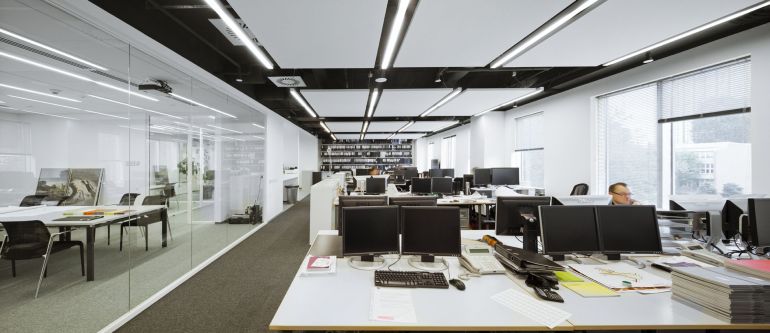Lighting requirements
The right lighting provided for work stations is a basic requirement, for which the employer is responsible. In a situation, when the employer cannot provide access to daylight, they must rely on other solutions, enabling good working conditions.
Legal requirements applying to lighting are specified in a variety of Acts. Minister of Infrastructure Regulation defines, for instance, the ratio of the number of windows in an office premises to its floor space, which should be 1:8. Polish legal norms also specify the minimum parameters of light intensity in a work station. For office work it should not fall below 500 luxes (lx), and the lighting ratio of adjacent rooms should not exceed 5:1, therefore the eyes will not feel the difference in the lighting (Norm PN-EN 12464-1:2004 Light and Lighting. Work place lighting).
Lighting adapted to the space
Providing appropriate lighting in the office space is not only a responsibility arising from the necessity to follow legal requirements, but mainly an act necessary to create comfortable working conditions. To make sure that the lighting in use is appropriate, it is important to bare in mind a few aspects of choosing the type of a lighting source and light fixtures.
While designing artificial lighting one should adhere to the following parameters: the lighting intensity in the work space, lighting evenness, unified glare rating UGR, colour temperature, colour rendering index and energy efficiency - stresses Piotr Burawski, Head of Programme Group PXF Lighting. It is also important to adapt lighting to interior arrangement, which also benefits the mood and makes work more efficient.
While choosing the best lighting one should pay attention to the type of the office space, which has to be lit. An individual work office will have completely different lighting requirements than an open space or a project design office.
In an individual work office it is necessary to lit only one desk. The most widely used form of lighting in this type of rooms is standard general lighting. To improve work comfort, accent lighting may also be used. A popular solution is the use of fixtures suspended above the work station - says Krzysztof Wojtas, Key Account Manager, Interbiuro. In case of additional lighting we have wall lamps at our disposal, projectors enabling us to direct the light, floor lamps and lighting (these days usually led) hidden in the ceiling niche and developments. To improve comfort, dividing fixtures should be connected to a few electrical circuits, so that they can be independently switched on and off, or taking a step further - dim and brighten them.
Completely different solutions should be employed in case of open space premises. A large work space, shared by many workers requires an even distribution of lighting. In such cases fixtures installed in the ceilings and overbuilt fixtures provide the perfect solution. There is also a possibility to provide additional lighting to particular desks: If the type of work requires it, there are special free-standing fixtures, put directly by the desk, equipped with special screens, which light the employee's worktop from above. Naturally, the most traditional solution, which is desk lamps, are also used often – adds Krzysztof Wojtas.
In terms of lighting, the most demanding work stations are project design offices. In such rooms the best solution is access to daylight. For that reason, a big number of glazed surfaces and additional skylights are a standard in such rooms. However, the intensity of daylight may prove unsatisfactory to allow for comfortable work. Because of that, apart from general lighting, installing detail lighting may be necessary - due to the necessity of working on various details on drawing tables for instance.
While choosing lighting for a project design office it is also important to remember to select the right lamps and light fixtures for computer work: To avoid light reflecting on computer screens, general as well as additional lighting used should be based on reflective light – stresses Krzysztof Wojtas.
Lighting paired with modernity
The above examples show that so called mixed lighting is the most popular choice for offices (meaning general lighting with additional detail lighting). This solution not only allows for appropriate conditions at a work station to be created, but also makes it easier to adapt the type of lighting to office arrangement.
The right lighting in an office space has to be paired with architectural arrangement. Often while creating a modern office arrangement the aspect of lighting requirements defined by Polish Norms is ignored. In this case a consultation with the lighting designer is necessary– says Piotr Burawski, Head of Programme Group PXF Lighting.
However, adapting the type of lighting to the arrangement of the office is not the only sign of modernity in this category. Modern technologies are being used more and more often, which allow not only for the optimisation of the lighting intensity in office spaces, but also improve the comfort of using it.
While designing lighting, more attention is now paid to making maximum use of daylight. In this case, automatic and controlled lighting should be used – explains Piotr Burawski. The use of modern LED light sources should also be mentioned in this discussion. A light-emitting diode is becoming a common source of light because of the decreased use of electric energy in comparison with standard sources of light, increasingly better lighting parameters, smaller dimensions and longevity – he adds.
Choosing the right lighting for an office space is difficult and requires a thorough analysis of the character of the office space, the number of employees, as well as the type of work done. For that reason it may be a good idea to consult the choice of lighting with a specialist. The number of solutions available on the market will allow for a provision of lighting that not only guarantees the perfect working conditions, but also one that suits the office space.

